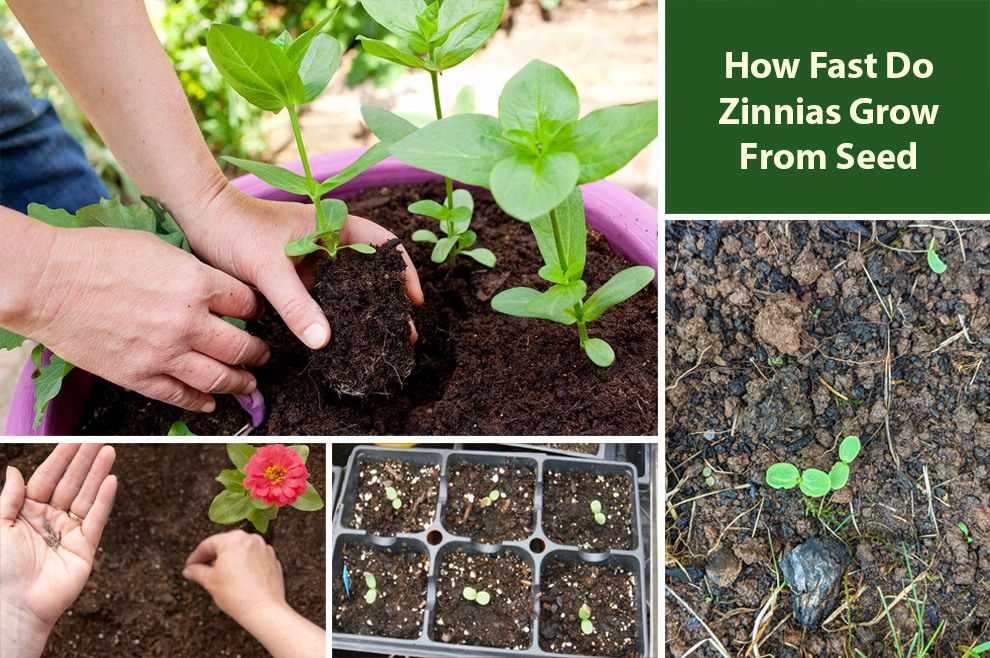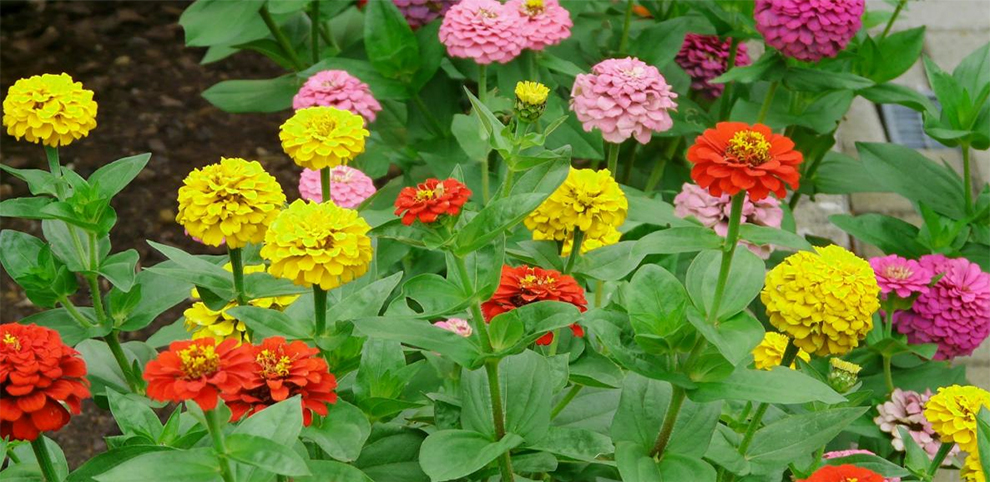How Long Do Zinnias Take To Bloom From Seed (Fast or Slow Growth Rate)
Zinnias have a fast growing nature. They typically produce colorful blooms in about seventy days when grown from seeds.

Zinnias, beloved for their colorful and vibrant flowers, are known for their quick growth from seeds to the blooming stage. The time they take for seeds to bloom can vary depending on the specific variety, climate, and growing conditions.
There is no exact way to tell how fast do zinnias grow from seed. Generally, zinnias typically take about sixty to seventy days from sowing the seeds to the first bloom.
The zinnia seed germination process is relatively fast and occurs within four to seven days upon optimal conditions. To ensure successful germination, you must sow zinnia seeds directly into well-drained soil post the last frost date, as they do not transplant well.
Plant seeds at approximately ¼ inch depth and keep them moist until germination occurs. After the seeds germinate, they develop into seedlings, and over the next couple of weeks, they grow, forming lush foliage and sturdy stems.
As the plants mature, they will yield colorful and attractive flowers. They last from summer to fall, making zinnias popular amongst gardeners and flower enthusiasts.
Are Zinnias Slow-Growing?
No, zinnias are not slow-growing plants. They have a relatively fast growth rate compared to other flowering plants.
But please note that the actual growth rate may vary depending on factors like climate, growing conditions, and the variety planted.
With favorable conditions and proper care, zinnias can establish and develop into sturdy plants with abundant flowers and lush foliage in a short time.
How Long Do Zinnias Take To Bloom From Seed?
As already established, Zinnias are known for their fast growth and the ability to yield colorful and vibrant blooms. From the seed germination to the bloom stage, zinnias need an average of sixty to seventy days.
But it is imperative to note that the precise timeline can vary depending on environmental factors and the variety chosen.
The seed germination, or the first stage in the process, typically takes around four to seven days under optimal conditions.
To foster germination, sow the zinnia seeds directly into well-drained soil following the last frost date. Ensure you plant the seeds at a depth of ¼ inch and keep them moist till they sprout.
After the seeds germinate, seedlings emerge from the soil. These seedlings will rapidly grow in the next few weeks, developing lush foliage and sturdy stems. The zinnia plants form buds upon maturity, opening into colorful and beautiful flowers.
With adequate sunlight, regular watering, and occasional feeding, zinnias continue to grow and develop their blooms. The flower color, shape, and size depend on the variety chosen.
The blooming period can last across summer into the fall, providing a stunning display of flowers in the containers, borders, or gardens.
Because of the relatively short period they take from seed to bloom, zinnias are favored by many flower enthusiasts and gardeners. Their fast growth rate and the ability to yield an abundance of flowers make them popular for adding beauty and color to any landscape.
Zinnia Growth Stages and The Timeline For How Fast Do Zinnias Grow In Each Stage
Every flower goes through some stages of growth. It starts from germination and culminates in the beautiful flowering stages. You can learn how to grow zinnias in pots here.
Once planted zinnias go through the following growth cycle in the approximate time mentioned below.
Germination
It is the initial stage of zinnia development, wherein the seed transitions from dormancy to active growth. The Zinnia seeds absorb water, swell, and break through the seed coat during germination.
The root or the radicle shows first, followed by the shoot or the plumule, which develops into the seedling.
Under ideal growing conditions, zinnia seeds germinate in about four to seven days. The precise length can vary depending on the seed quality, moisture, and temperature. Warm soil temperatures between 70 to 75°F (21 to 24°C) promote faster germination.
To facilitate germination, you must sow the seeds directly into well-drained soil after the last frost date. Plant them into the soil at an apt depth and keep them moist till germination kickstarts.
Use peat pots or seed-starting mix to provide optimal moisture and aeration. Please note that not all zinnia seeds germinate simultaneously. Germination can occur over several days, with some seeds sprouting faster than others. This staggered germination pattern is usual.
In the germination phase, zinnias develop their initial root system and absorb nutrients from the soil to support the subsequent stages. After germination, the seedlings advance to the next growth stage: seedling.
Seedling

It is the second phase in the zinnias growth cycle. At this stage, zinnia seedlings show from the soil with their first pair of true leaves. These leaves will vary from the initial seed leaves and depict the plant’s transition to the next growth stage.
Typically, seedlings take two to three weeks from germination to reach this stage. At this point, seedlings establish their root system and develop additional sets of leaves, building their energy reserves for subsequent growth.
You must provide proper care during this phase to ensure healthy development. It involves maintaining consistent soil moisture, providing ample sunlight or artificial light if grown indoors, and avoiding overcrowding by thinning out weaker seedlings if necessary.
When the seedlings grow, they become sturdier, developing stronger stems and more mature foliage. This growth prepares them for the subsequent stages, including vegetative growth and flowering.
Vegetative Growth

The vegetative growth stage is a crucial period in the zinnias’ development, characterized by rapid growth and the formation of mature foliage. In this phase, the zinnia plants focus on their robust development. So, the plant develops an abundant leaf canopy and sturdy stems.
Zinnias usually reach the vegetative growth phase in approximately three to four weeks post-germination. But it may vary depending on the growing conditions and the care offered.
Providing adequate sunlight, occasion feeding, and regular feeding can promote healthy vegetative growth.
In this phase, zinnias divert their energy towards leaf production and expansion, establishing vibrant and dense foliage canopy. The leaves aid in photosynthesis, allowing the plants to produce and store energy for further flower development.
As the vegetative growth advances, zinnias might demand support, such as trellising or staking, to keep the stem upright and prevent breaking or bending. Pinching back the plants or pruning can aid in promoting branching and a bushier growth habit.
Flowering
It is the most visually rewarding and anticipated stage of the zinnia growth. In this stage, zinnias produce many attractive and colorful flowers, showcasing the plant’s beauty. Zinnias usually reach the flowering stage about eight to ten weeks after the seed germination.
After the flowering stage commences, the plant continues to produce flowers for an extended duration, typically lasting from summer through fall. The exact blooming period can vary, but with proper care, zinnias can provide a profusion of blooms for several weeks.
The flowers come in diverse sizes, shapes, and colors depending on the variety planted. From daisy-like to pom-pom-shape, double-petaled to single-petaled, zinnia flowers add color and charm to the containers, borders, or gardens.
To ensure continual flowering, deadhead or remove the faded blooms regularly. It directs the plant to employ its energy towards new flowers rather than seed production.
With favorable growing conditions and proper maintenance, zinnias can delight flower enthusiasts and gardeners with their eye-catching blooms across the flowering stage.
You know how fast do zinnia seeds grow, but what if your zinnias do not grow at this pace? Is there something you can do? Please read the section below as we discuss some factors to influence the zinnias’ growth rate.
How Do You Make Zinnias Grow Faster?
If you are looking to speed up the growth of your zinnias and witness their vibrant blooms sooner, there are several strategies you can employ to make them grow faster.
A. Choose a fast-growing specie
When you wish to accelerate the growth of your zinnias, the first requirement is picking the fast-growing species. They have an immense role in ensuring quick results. Some of the recommended zinnia varieties known for their fast growth rate are as follows:
- Profusion series
- State Fair series
- Thumbelina series
- Cactus variety
B. Meet the nutritional needs of zinnia plants
Meeting the plant’s nutritional needs is also necessary to promote faster growth. Here are some tips to ensure your plant gets the required nutrients:
- Soil quality: Always plant zinnias in well-draining soil rich in organic matter. You can amend the soil with well-rotted manure or compost before planting to better its nutrient structure and content.
- Fertilization: Add a slow-release, balanced plant food or a water-soluble fertilizer exquisitely formulated for flowering plants. Please follow the package instructions for frequency and application rates. Do not overfeed. It can result in excessive foliage growth at the expense of flower production.
- Micronutrients: Zinnias need micronutrients like manganese, magnesium, and iron. Use a micronutrient foliar spray or fertilizer to ensure your plant gets these essential nutrients.
- pH levels: Zinnias cherish neutral to acidic soils with a pH range between 6.0 and 7.0. So, perform a soil assessment test and make amendments as needed.
C. Environmental factors
[image]
Creating favorable environmental conditions can also help with faster growth. Here are some factors you must remember:
- Sunlight: Zinnias thrive in full sun. They need at least six to eight hours of direct sun daily. So plant your zinnias where they can get ample sunlight to maximize their growth potential.
- Temperature: Zinnias love warm temperatures between 70 to 85°F (21 to 29°C). Planting them after the last frost date in your region ensures they do not get exposed to cold temperatures that can stunt their growth.
- Watering: Give Zinnias consistent moisture, but do not overwater. Water deeply when the top inch of the soil feels dry, allowing the roots to access water and nutrients. Do not waterlog the soil to avoid root rot.
- Air circulation: Ample air circulation can help prevent fungal diseases. So, grow the zinnias in an area to ensure adequate spacing between them for good airflow and to reduce the risk of fungal infestations.
- Mulching: Apply an organic mulch layer around the plants to help regulate soil temperature, conserve moisture, and suppress weed growth. It creates a favorable microenvironment for the plants.
D. Pest control
Incorporating effective pest control measures is also crucial for Zinnias’ healthy and fast growth. Here are some guidelines to keep pests at bay.
- Inspect regularly for signs of pests.
- Manually remove the larger pests like beetles or caterpillars and dispose of them.
- Encourage beneficial insects like praying mantises, lacewings, and ladybugs that feed on pests.
- In severe infestation, use organic insecticides like insecticidal soaps or neem oil.
- Promote plant health by ensuring adequate space between zinnias to ensure good air circulation and practice proper watering techniques.
- Maintain proper sanitation by removing fallen plant debris or leaves to prevent the spread of diseases.
What Are The Fastest Maturing Zinnias?
The Peter Pan series of zinnias stands out as one of the quickest to initiate blooming, often starting to produce flowers in as little as six weeks from sowing the seeds.
